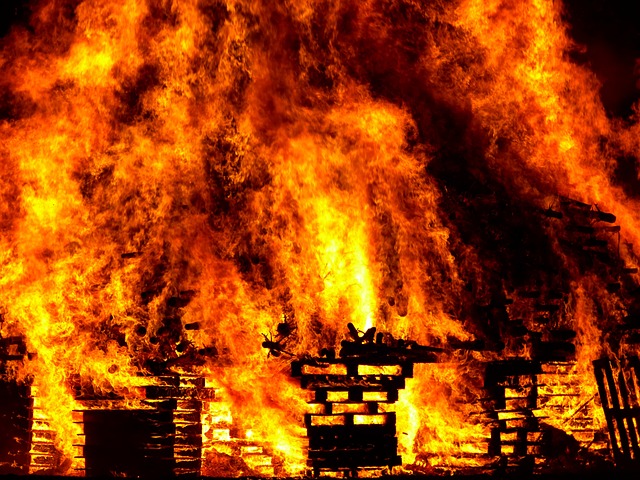
Ensuring Safety in Hospitality: The Vital Role of Passive Fire Protection Amidst Arson Threats in Ireland
Fire safety has long been a significant concern in the hospitality sector, but recent trends suggest its importance is growing more than ever. Rising arson threats in Ireland have led to an increased emphasis on safety measures, particularly passive fire protection. As hoteliers strive to provide a welcoming and safe environment for their guests, they are faced with the task of integrating these safety systems without compromising the aesthetic appeal or comfort of their establishments. Passive fire protection systems play an essential role in this environment, as they are designed to contain fires in the event of an outbreak, limiting damage and giving occupants the precious time needed to evacuate safely.
Passive fire protection (PFP) refers to measures implemented within a building’s structure to prevent, slow, or contain the spread of fire and smoke. These measures are built into the very fabric of a building and do not require any human intervention or power supply to function effectively. PFP methods include the use of fire-resistant walls, floors, and doors, as well as fire-stop materials in walls and floors, which can impede the spread of fire from one area to another. This integral part of fire safety strategy works in tandem with active fire protection systems, such as sprinkler systems and fire extinguishers, contributing significantly to the overall safety of the occupants within the building.
Recent arson attacks in Ireland have unfortunately been connected with the hospitality industry, causing a rise in concerns and prompting stronger safety measures. Incidents such as the unfortunate fire at a hotel in County Donegal and another at a guesthouse in County Meath are sobering reminders of the vulnerability of the sector.
These occurrences not only result in significant financial loss but, more importantly, pose a threat to human lives. The connection between these arson attacks and the hospitality industry underscores the pressing need for effective passive fire protection systems within such establishments, to ensure the safety of guests and staff alike. These incidents serve as a call to action for hospitality providers to review and reinforce their fire safety strategies, with a focus on the implementation and maintenance of quality passive fire protection measures.
Understanding Passive Fire Protection (PFP)
Understanding passive fire protection involves appreciating its function as a key component of a comprehensive fire safety strategy. It is primarily intended to contain a fire at its point of origin, preventing the spread of flames and smoke through the building, thus buying valuable time for occupants to escape and for fire services to respond.
At the heart of passive fire protection are several key elements. These include fire-resistant walls and floors, designed to compartmentalise a building and inhibit the spread of fire. Fire doors serve a similar function, preventing the spread of fire and smoke whilst allowing safe escape routes. Fire-stopping materials, such as seals around pipes and cables, prevent the spread of fire through service openings. Finally, fire-resistant glazing can help contain a fire while also providing escape route visibility. Each of these components plays a crucial role, working together to limit the impact of a fire and protect building occupants.
By understanding the components and purpose of passive fire protection, we can better appreciate its vital role in creating a safer environment in the hospitality sector. Continued education and investment in these systems are fundamental in the fight against potential fire threats.
The Role of Passive Fire Protection in the Hospitality Industry
In the hospitality industry, the implementation of passive fire protection has a significant function in maintaining the safety and welfare of both guests and staff. Its primary role is to provide a ‘fire-safe’ environment that helps limit the spread of fire and smoke, thereby reducing potential injuries and damage.
In a hotel setting, for instance, fire-resistant walls and doors are instrumental in compartmentalising the building. These compartments function as safe zones, helping to contain a fire in a specific area and preventing its spread to other parts of the building. This is particularly important in hotels, as guests may be unfamiliar with the layout of the building, and in the event of a fire, these fire-resistant compartments can provide safe refuge.
Fire-stopping materials, another key component of passive fire protection, have an equally important role. They are used to seal off any openings or gaps that could provide channels for fire or smoke to spread throughout the building. In a busy hotel or restaurant, where multiple utilities and services are in operation, these materials are essential in enhancing the overall fire resistance of the building.
Lastly, the use of fire-resistant glazing in the hospitality industry should not be underestimated. While its primary function is to contain the spread of fire, the added benefit is its transparency. This allows guests and staff to see through the glazed areas, assisting in identifying safe routes and exits during evacuation.
In conclusion, passive fire protection serves as a silent guardian in the hospitality industry, seamlessly integrated into the building’s structure to minimise fire-related risks. Its role is crucial, and its importance cannot be overstated in the face of rising arson threats in the sector. It is incumbent on all stakeholders in the hospitality industry to understand and invest in these systems, to continually strive to provide a safe and secure environment for all.
How Precisely Does Fire Stopping Work?
In the event of a fire, passive fire protection systems come into play by effectively compartmentalising the building into smaller, contained sections. These compartments are designed to resist the penetration of fire long enough for occupants to be evacuated safely. For instance, fire-resistant walls and floors halt the rapid spread of flames across rooms, corridors, or floors. Fire doors, when closed, act as a barrier to prevent the further spread of fire and smoke, thus protecting escape routes and facilitating safe evacuations.
Fire-stop materials, such as seals around pipes and cables, block the potential pathways for fire and smoke. They prevent the spread of fire through ‘service penetrations’ in walls, ceilings and floors, which can otherwise act as a conduit for fire to move around the building. Similarly, fire-resistant glazing restricts the spread of fire while maintaining clear visibility, which can be crucial during evacuation procedures.
In essence, the goal of passive fire protection in an emergency is to hinder the progress of a fire, protect escape routes, and ensure that the building remains as safe as possible for as long as possible. This valuable time allows for emergency services to arrive and take control of the situation, further enhancing the chance of preservation and safety for both individuals and property.
The Irish Context: Arson Attacks and Hospitality Vulnerability
Recently, Ireland has experienced a spate of arson attacks targeting the hospitality sector, presenting a significant cause for concern. These malicious incidents have ranged from small-scale attacks on individual properties to larger, more destructive acts resulting in substantial damage. High-profile cases include the attack on the Great Southern Hotel in Rosslare Co Wexford which was subjected to an arson attack while it was under consideration as a centre to house asylum seekers. Similarly, the Ross Lake Hotel in Roscahill in Galway was completely destroyed due to an arson attack.
These incidents are not isolated, with several other hospitality establishments across the country also falling victim to such attacks. These distressing events underscore the vulnerability of the hospitality sector in Ireland to arson threats, emphasising the necessity for rigorous fire safety strategies and the importance of robust passive fire protection measures.
These deliberate arson attacks pose a grave threat to Ireland’s hospitality sector, with far-reaching implications for safety, business continuity, and even the country’s tourism reputation. From a safety perspective, an incendiary attack places the lives of staff, guests, and emergency responders at extreme risk. Even with rigorous passive fire protection measures in place, the unpredictable nature of arson can lead to rapid fire spread, potentially overwhelming safety systems and making safe evacuation more challenging.
In terms of business continuity, the aftermath of an arson attack can be disastrous. The physical damage to premises can result in prolonged closures, interrupting daily operations and leading to significant loss of income. Moreover, the time and financial cost of repairs, not to mention the potential increase in insurance premiums following an attack, further exacerbate the economic impact.
Finally, the psychological impact on staff and guests can be highly detrimental and may result in lasting reputational damage for the affected establishment and the broader hospitality sector. If not addressed properly, such events could deter potential visitors, impact tourism, and ultimately affect the sector’s overall contribution to the Irish economy. Therefore, it’s not just an issue of physical fire safety measures, but also a matter of crisis management and resilience planning in the face of such threats.
Implementing Effective Fire Stopping Solutions
The implementation of effective fire-stopping solutions is essential to safeguard hotels and other hospitality venues. Foremost, a comprehensive fire risk assessment should be conducted. This provides a detailed understanding of potential fire hazards, and the steps needed to mitigate such risks. This assessment must be carried out by a competent individual or organisation and reviewed regularly.
Fire-resistant walls, ceilings, and floors form the primary line of defence. These should be robust and properly tested, providing at least 60 minutes of fire resistance. Fire doors are equally important, and they should self-close to ensure they remain shut when not in use. Regular maintenance and inspection of these doors are crucial to ensure they continue to perform optimally.
Fire-stop materials, including seals around pipes and cables, are key to preventing fire spread through service penetrations. It’s crucial to use tested and approved products, as the quality of these materials directly impacts their effectiveness.
Emergency lighting and clearly marked exit routes are mandatory, providing a safe path for evacuees. Regular drills should be scheduled to familiarise staff and guests with evacuation procedures.
Fire detection and alarm systems should be installed throughout the venue. These systems must be regularly tested and maintained to ensure they are operational.
Fire safety training for all staff members is a must. A well-trained workforce can help prevent fires, make appropriate decisions during emergencies and ensure the safety of guests.
Lastly, a well-thought-out and rehearsed fire emergency plan is essential. This plan should include details like the evacuation process, assembly points, communication methods during emergencies, roles, and responsibilities.
Through the implementation of these measures, hospitality venues can significantly reduce the risk of fire events, protect occupants, and ensure business continuity in the unfortunate event of a fire.
Compliance and Regulations in the Hospitality Sector in Ireland
In Ireland, fire safety regulations for the hospitality sector are guided by the Fire Services Act of 1981 and 2003, and the Building Control Act of 1990 and 2007. Under these acts, it is a legal requirement for establishments to conduct periodic fire safety assessments and implement necessary fire safety measures. The onus is on the hotel or hospitality venue to ensure they meet the prescribed fire safety standards.
The Irish Standards (IS) 3217:2013 outlines the code of practice for emergency lighting systems, while the IS 3218:2013 provides guidelines on fire detection and alarm systems. Similarly, the Technical Guidance Document B (TGD B) outlines stringent requirements regarding fire safety in new and existing buildings, including those in the hospitality sector. This document covers the provision of fire-resistant materials, compartmentation, escape routes, and emergency lighting among others.
Furthermore, the Safety, Health and Welfare at Work Act 2005 stipulates that employers must ensure the safety, health and welfare of all employees. This includes providing information, instruction, training and supervision about fire safety. For instance, all staff members should be made aware of the fire emergency plan, fire hazards, and fire safety measures within the premises.
Non-compliance with these regulations can result in severe penalties, including fines and imprisonment. More importantly, failure to adhere to these regulations can lead to tragic consequences in the event of a fire. Hence, it is not only a legal obligation but also a moral one to ensure the highest level of fire safety in the hospitality sector.
Overall, compliance with fire safety regulations forms the backbone of effective fire safety management within the hospitality sector in Ireland. By following these regulations, establishments can ensure the safety of their staff and guests, minimise fire damage, and maintain business continuity.
Proactive Measures Against Arson Threats
To mitigate risks of arson within the hospitality sector, it is essential to adopt proactive measures. Firstly, a thorough security assessment can identify potential vulnerabilities that may be exploited by arsonists. This could include unsecured access points, inadequate lighting in external areas, and lack of surveillance systems. Implementing improvements in these areas can greatly deter potential arsonists.
The utilisation of a robust CCTV system is also crucial. Not only does this act as a deterrent, but it can also provide valuable evidence in the event of an arson attack. Regular checks should be carried out to ensure that all cameras are functioning properly and are strategically placed.
Moreover, waste management should be a major consideration. All waste materials, particularly flammable ones, should be stored securely and away from the main building. Regular waste collection should also be arranged to prevent accumulation.
The Role of Staff Training and Awareness Programs
The role of staff in preventing arson cannot be underestimated. Comprehensive training should be provided to all personnel to raise awareness about the threat of arson, its consequences, and the signs of suspicious activity. Staff should be encouraged to report any unusual activity or concerns to management promptly.
Aside from training, regular awareness programs can reinforce this knowledge and keep the threat of arson at the forefront of staff consciousness. The consistent delivery of these programs will foster a proactive culture around security and fire safety.
Furthermore, emergency response training should be provided. This will ensure that in the unlikely event of an arson attack, staff are prepared to act swiftly and effectively, minimising harm, and potentially saving lives.
Through the implementation of these proactive measures and the empowerment of staff, the hospitality sector can significantly mitigate the risk of arson, protect its assets, and ensure the safety of its guests and employees.
The Future of Fire Safety in Irish Hospitality: Emerging Trends and Technologies in Passive Fire Protection
The future of fire safety in the Irish hospitality sector is being shaped by several emerging trends and technological advancements in passive fire protection. Passive fire protection, which primarily focuses on containing fires and preventing their spread, is witnessing a shift towards the integration of innovative materials and intelligent systems.
One such trend is the rise of smart materials in fire safety design. These materials, such as intumescent coatings, expand when exposed to heat, creating a protective barrier that prevents the spread of fire. They are being increasingly used in structural elements and furnishings within hospitality venues, enhancing their fire resilience.
Another noteworthy development is the integration of fire safety into Building Information Modelling (BIM). BIM provides a digital representation of the physical and functional characteristics of a building, allowing for the comprehensive planning, design, and management of fire safety measures. This holistic approach is expected to enhance the effectiveness of passive fire protection strategies.
Furthermore, there is a growing emphasis on the use of fire safety engineering principles in designing buildings. This approach takes into account various factors such as occupant behaviour, evacuation strategies, and fire dynamics, enabling the customisation of fire safety measures to the specific needs of a venue.
These emerging trends and technologies are poised to significantly improve the fire safety preparedness of the Irish hospitality sector, ensuring a safer and more secure environment for both guests and staff.
Conclusion
In conclusion, passive fire protection plays a pivotal role in securing the Irish hospitality industry. As the sector continues to innovate and embrace new technologies, the integration of passive fire protection measures – such as the utilisation of smart materials in fire safety design, the integration of fire safety into Building Information Modelling, and the application of fire safety engineering principles – becomes increasingly critical. These strategies not only assist in containing fires and preventing their spread, but also ensure the safety of both guests and staff. The industry’s shift towards these strategies is a testament to its commitment to creating a safe and secure environment.
For further guidance in enhancing your venue’s fire safety measures, consider reaching out to Flame Stop for a Fire Stopping Consultation. As experts in the field, they can provide valuable insights and recommendations tailored to your specific needs. Elevate the safety standards within your establishment and take proactive action today. Contact Flame Stop to learn more.


